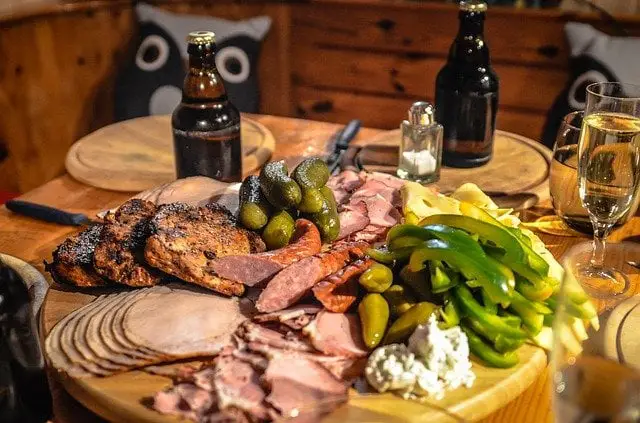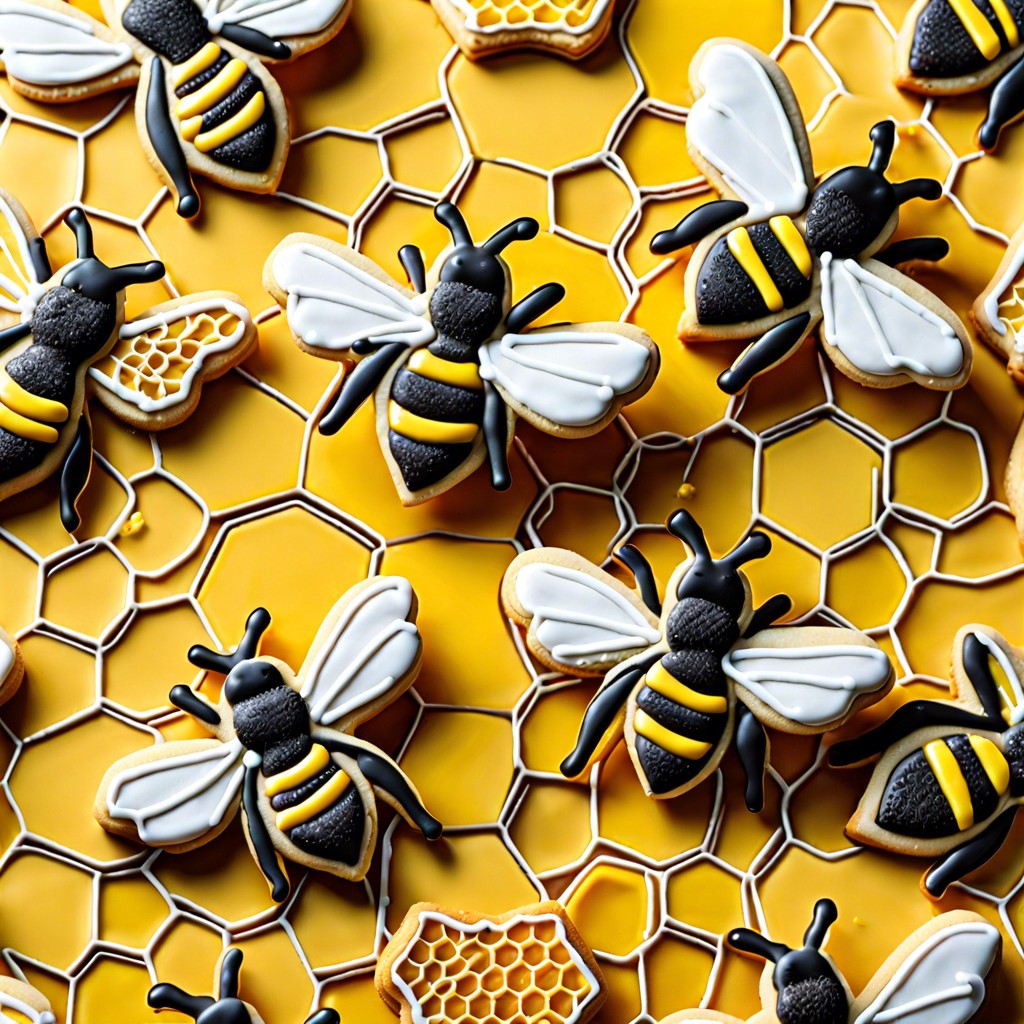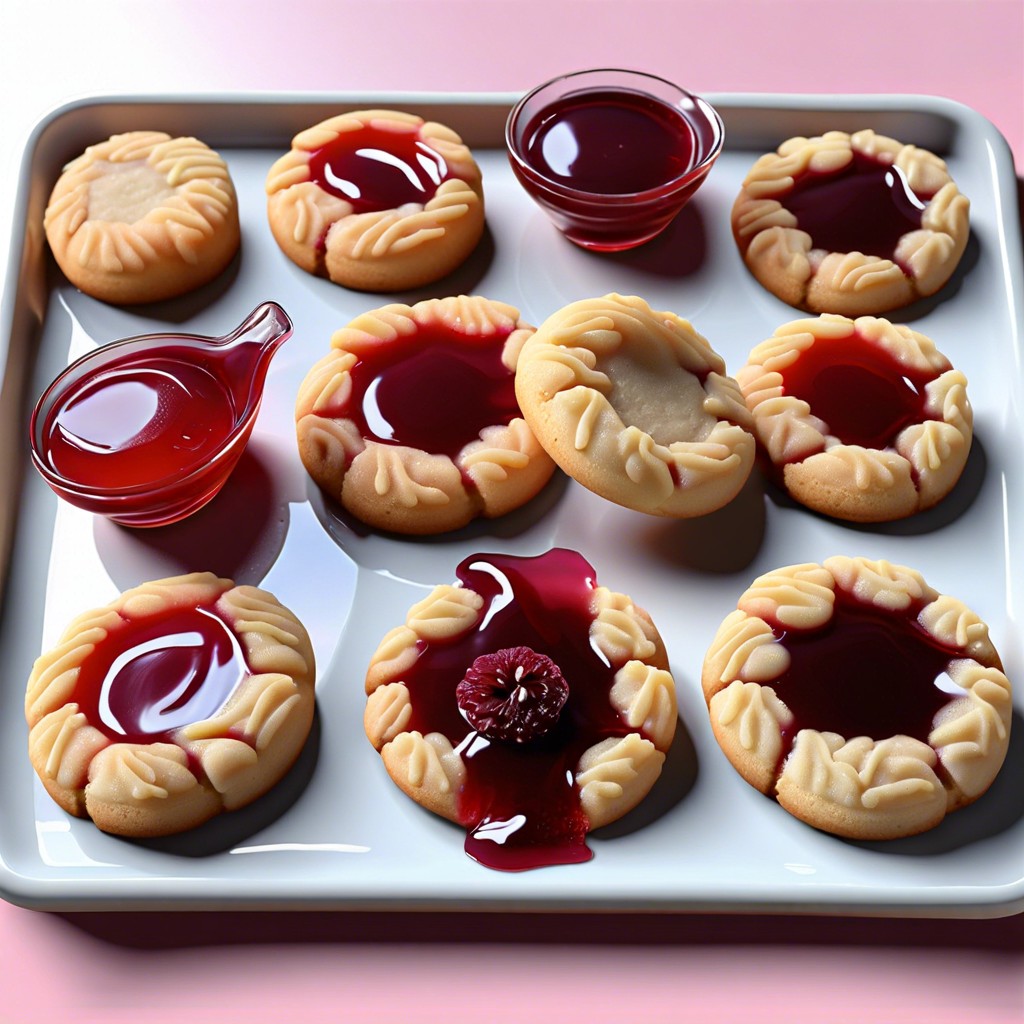Discover the perfect selection of meats for your charcuterie board that will tantalize your taste buds and impress your guests.
Charcuterie boards have become increasingly popular in recent years, and for good reason. They are a perfect way to showcase an array of delicious meats, cheeses, fruits, and nuts.
But with so many options out there, it can be overwhelming to know which meats to choose for your charcuterie board. In this article, we will explore the best meats for charcuterie and why they are perfect additions to any board.
So grab a glass of wine and let’s dive into the world of charcuterie!
Cured Meats

Cured Meats: Curing is a traditional method of preserving meat that has been used for centuries. Cured meats are made by adding salt, nitrates, and other seasonings to the meat and allowing it to dry or ferment over time.
This process not only preserves the meat but also enhances its flavor.
Some popular cured meats for charcuterie boards include prosciutto, pancetta, and bresaola. Prosciutto is a type of Italian ham that is thinly sliced and has a delicate texture with sweet notes in taste.
Pancetta comes from pork belly which gets seasoned with spices such as nutmeg before being rolled up tightly into cylinders then aged until ready to be sliced thin like bacon strips.
Bresaola on the other hand originates from Italy’s Lombardy region where beef rounds get rubbed down with herbs like rosemary before getting hung up in cool rooms for months at a time until they become firm enough to slice paper-thin.
Dry-cured Sausages
These sausages are made by grinding meat, adding spices and curing agents, stuffing the mixture into casings, and then hanging them to dry for several weeks or months. The result is a flavorful sausage that can be sliced thin and enjoyed with other meats or cheeses.
Some popular varieties of dry-cured sausages include pepperoni, chorizo, salami, soppressata and more. Each type has its unique flavor profile due to the different types of meat used in their production as well as the spices added during preparation.
When selecting dry-cured sausage for your charcuterie board consider choosing a variety of flavors such as spicy chorizo or mild salami to cater to different tastes preferences among your guests.
Smoked Meats
Smoking adds a unique flavor to the meat and can be done with various types of wood, such as hickory or applewood. Some common smoked meats you might find on a charcuterie board include smoked ham, turkey breast, and beef brisket.
Smoked salmon is also a great addition to any seafood-themed board. When selecting your smoked meats for your charcuterie board, it’s important to consider the level of smokiness you prefer in your meat.
Some people enjoy heavily-smoked flavors while others prefer more subtle hints of smoke. Pairing suggestions: For those who love bold flavors, pair heavily-smoked meats with strong cheeses like blue cheese or aged cheddar.
If you prefer milder tastes, try pairing lightly-smoked salmon with cream cheese or goat cheese spread on crackers or crostini for an elegant appetizer that will impress any guest at your next gathering!
Pâtés and Terrines
These savory spreads are made by blending ground meat with fat, herbs, spices, and other flavorings. They can be served cold or at room temperature and pair perfectly with crusty bread or crackers.
One of the most popular pâtés is foie gras, which is made from the liver of a duck or goose that has been fattened through force-feeding. This luxurious spread has a rich buttery texture and pairs well with sweet jams or chutneys.
Terrines are similar to pâtés but have chunkier textures due to the addition of coarser meats like pork shoulder or beef chuck. They can also include vegetables like mushrooms, onions, carrots for added depth in flavor.
Rillettes
This spreadable meat dish is made by slow-cooking pork or other meats in fat until they become tender and easily shredded. The meat is then mixed with the cooking fat, herbs, and spices to create a rich and flavorful spread.
One of the great things about rillettes is their versatility. They can be served on their own as a delicious appetizer or used as an ingredient in other dishes such as sandwiches or pasta sauces.
When selecting rillettes for your charcuterie board, look for options made from high-quality ingredients like free-range pork and organic herbs. Pair them with crusty bread, crackers, cornichons (small pickled cucumbers), mustard or honey to balance out the richness of this decadent treat.
Prosciutto Selection
It’s made from the hind leg of pigs and is typically aged for at least 12 months, resulting in a delicate texture and rich flavor. When selecting prosciutto for your charcuterie board, it’s important to consider its origin and quality.
There are two main types of prosciutto: Prosciutto di Parma and Prosciutto di San Daniele. Both are protected by European Union law, ensuring they meet strict production standards.
Proscuitto di Parma comes from the Emilia-Romagna region of Italy while Proscuitto di San Daniele comes from Friuli-Venezia Giulia.
When choosing between these two varieties, it ultimately comes down to personal preference as both offer unique flavors that can complement different cheeses or fruits on your board. However, keep in mind that high-quality proscuitto should have an even color throughout with visible fat marbling – this indicates proper aging techniques were used during production.
Salami Varieties
From spicy to mild, there’s a salami for every taste preference. Some popular types of salami include Genoa, soppressata, and pepperoni.
Genoa salami is made with pork and beef and has a slightly sweet flavor with hints of garlic. It pairs well with sharp cheeses like cheddar or gouda.
Soppressata originates from southern Italy and has a coarser texture than other types of salamis due to its hand-chopped meat. It’s often seasoned with red pepper flakes for some added heat.
Pepperoni is perhaps the most well-known type of salami in America thanks to its popularity on pizza toppings. Made from cured beef or pork mixed with spices like paprika, it has a bold flavor that can stand up against strong cheeses like blue cheese or feta.
Mortadella
It originated in the city of Bologna and is made from finely ground pork, flavored with spices such as black pepper and myrtle berries, then slow-cooked to perfection. Mortadella has a smooth texture and delicate flavor that pairs well with other meats on your charcuterie board.
One of the unique features of mortadella is its signature white specks throughout the meat. These are actually cubes of pork fat called “lardons” which add richness to each bite.
When selecting mortadella for your charcuterie board, look for high-quality options made from all-natural ingredients without any fillers or additives. Serve it sliced thin alongside other cured meats like prosciutto or salami, paired with crusty bread and tangy pickles for an unforgettable taste experience.
Chorizo
It is made from pork, paprika, garlic, and other spices. Chorizo can be found in both fresh and cured varieties.
Fresh chorizo has a soft texture and must be cooked before eating. It’s perfect for grilling or frying as it adds an intense flavor to any dish.
Cured chorizo has a firmer texture due to the drying process it undergoes during production. This type of chorizo can be sliced thinly for use on charcuterie boards or added to sandwiches for an extra kick of flavor.
Chorizos come in different types depending on their region of origin; Spanish-style chorizos are usually smoked while Mexican-style ones tend to have more heat from chili peppers.
Bresaola
It is made by curing lean cuts of beef, such as top round or eye of round, with salt and spices like juniper berries, black pepper, and garlic. The meat is then hung to dry for several weeks until it becomes firm and dark red in color.
Bresaola has a delicate flavor that pairs well with other meats on a charcuterie board. Its texture is tender yet slightly chewy which makes it perfect for wrapping around cheese or fruit slices.
When selecting bresaola for your charcuterie board, look for high-quality cuts that are thinly sliced to enhance its tenderness. Serve alongside some crusty bread and olives to create an authentic Italian experience at home.
Speck
It is made by smoking and curing pork legs with a blend of spices, including juniper berries, garlic, and bay leaves. The result is a deliciously smoky flavor with hints of sweetness.
Speck can be enjoyed on its own or paired with other meats on your charcuterie board. Its unique flavor profile makes it an excellent addition to any cheese platter as well.
When selecting speck for your charcuterie board, look for slices that are thin but not too delicate so they won’t fall apart when placed on the board. Pair it with mild cheeses like brie or gouda to balance out its bold flavors.
Pancetta
It’s a popular addition to charcuterie boards because of its rich, savory flavor and versatility in cooking. Pancetta can be enjoyed on its own or used as a flavorful ingredient in many dishes, such as pasta carbonara or wrapped around vegetables for grilling.
One of the unique characteristics of pancetta is that it’s cured but not smoked like traditional bacon. Instead, it’s seasoned with salt and spices such as black pepper, nutmeg, fennel seeds or garlic before being rolled up tightly into a cylinder shape and left to cure for several weeks.
When selecting pancetta for your charcuterie board look out for thinly sliced pieces which are perfect when served alongside other meats like prosciutto di Parma or salami Milano. You can also try wrapping small pieces around breadsticks or melon slices to add some extra flavor.
Jamón Iberico
These pigs are known for their unique diet of acorns, which gives the meat its distinct flavor. Jamón Iberico can be found in two different varieties: Jamón Ibérico de Bellota and Jamón Ibérico de Cebo.
Jamón Ibérico de Bellota is considered to be the highest quality variety as it comes from free-range pigs that have been allowed to roam freely in oak forests and feed on acorns during their last few months of life. This results in a rich, nutty flavor with a melt-in-your-mouth texture.
On the other hand, Jamón Ibérico de Cebo comes from pigs that have been raised on farms where they are fed grain-based diets instead of acorns. While still delicious, this variety lacks some of the depth and complexity found in its bellota counterpart.
Capicola
It’s made from the muscle running from the neck to the fourth or fifth rib of a pig and has a rich flavor with just the right amount of fat.
The process of making capicola involves rubbing it with salt and spices such as paprika, garlic, fennel seeds, and black pepper before letting it cure for several weeks. The result is a tender meat that can be sliced thin or thick depending on your preference.
Capicola pairs well with other meats like prosciutto and salami but also goes great with cheeses like provolone or mozzarella. Add some olives and crackers to complete your charcuterie board.
Soppressata
It’s made with coarsely ground pork, seasoned with garlic and hot pepper flakes, and then stuffed into natural casings. The sausage is then hung to dry for several weeks or even months until it develops its signature tangy flavor.
Soppressata has a distinct texture that sets it apart from other cured meats on your charcuterie board. Its coarse grind gives it a rustic appearance while also providing an excellent chewiness that pairs well with crackers or bread.
When selecting soppressata for your charcuterie board, look for varieties labeled “piccante” (spicy) if you want to add some heat to your spread. Alternatively, “dolce” (sweet) soppressatas are milder in flavor but still pack plenty of savory goodness.
Lomo
It is made by marinating the meat in salt and spices before being air-dried for several months. The result is a tender and flavorful meat with a slightly sweet taste.
Lomo pairs well with other meats on your charcuterie board such as prosciutto or salami. Its mild flavor makes it an excellent choice for those who prefer less intense cured meats.
When selecting lomo for your charcuterie board, look for slices that are thinly cut to allow its delicate texture to shine through. Serve it alongside some crusty bread and olives to complete the perfect Spanish-inspired spread.
Coppa
It is made from the muscle running through the neck and shoulder of the pig and is dry-cured with salt, sugar, and spices such as paprika or red pepper flakes.
The result is a tender meat with a rich flavor profile that pairs perfectly with other meats like prosciutto or salami. Coppa can be sliced thinly for easy snacking or added to sandwiches for an extra burst of flavor.
When selecting coppa for your charcuterie board, look for pieces that are evenly marbled throughout without any large chunks of fat. This will ensure you get the best texture and taste possible.
Coppa adds depth to any charcuterie board thanks to its unique blend of flavors.
Landjäger
It’s made from beef, pork, or game meat and is seasoned with spices like coriander, caraway seeds, and garlic. The name “landjäger” translates to “country hunter,” as it was originally created as a portable snack for hunters who spent long periods of time in the woods.
This sausage has become increasingly popular on charcuterie boards due to its unique flavor profile and texture. Landjäger has a firm texture that makes it easy to slice thinly for snacking or pairing with other meats on your board.
When selecting landjäger for your charcuterie board, look for high-quality options made from grass-fed animals without any added hormones or antibiotics.
Guanciale
It has a rich, fatty flavor and is often used in traditional dishes like carbonara and amatriciana. Guanciale is typically seasoned with salt, black pepper, garlic, and sometimes chili flakes before being hung to dry for several weeks.
One of the unique characteristics of guanciale compared to other cured meats like pancetta or prosciutto is its texture. The fat content in guanciale gives it a softer texture than other types of pork belly-based charcuterie.
When selecting guanciale for your charcuterie board or recipe, look for pieces that are evenly marbled with fat throughout the meat. This will ensure maximum flavor and tenderness when cooked.
Cecina
It is made by salting and air-drying beef, typically from the hindquarters of the animal. The result is a thin, dark red slice with an intense flavor that pairs well with other meats on a charcuterie board.
Cecina has been produced in Spain for centuries and was originally used as sustenance for soldiers during long campaigns. Today it remains popular throughout the country and can be found in many restaurants and markets.
When selecting cecina for your charcuterie board, look for slices that are thinly cut to allow its unique flavor to shine through. Pair it with other Spanish meats such as chorizo or jamón ibérico along with some olives or almonds to create an authentic Spanish experience right at home.
Cecina may not be as well-known as some of its counterparts like prosciutto or salami but it certainly deserves a spot on any charcuterie board due to its rich history and delicious taste profile!
FAQ
What kind of meats to use on a charcuterie board?
Suitable meats for a charcuterie board include salami, mortadella, prosciutto, sausage, and chorizo, with the first three being the most common due to their spreadability and flavor.
What are standard charcuterie meats?
Standard charcuterie meats include dry-cured pork, Serrano ham, prosciutto, country ham, Iberico ham, capicola, and speck.
What is the best meat for a cheese platter?
The best meat for a cheese platter is cured meats, such as sausages, salumis, and hams (e.g., prosciutto, soppressata, and speck), preferably in both cut and uncut forms.
What is a good alternative to salami on a charcuterie board?
A good alternative to salami on a charcuterie board could be pepperoni, bresaola, or culatello, as they offer different flavors and textures.
What types of cured meats pair well with specific cheeses on a charcuterie board?
Prosciutto pairs well with mozzarella, salami with provolone, and spicy chorizo with manchego on a charcuterie board.
How can I incorporate smoked meats in a charcuterie selection?
Incorporate smoked meats in a charcuterie selection by choosing a variety of types, flavors, and textures, such as smoked sausages, smoked ham, and smoked salmon, to create a diverse and appealing platter.
Are there any regional or ethnic specialty meats ideal for a charcuterie platter?
Regional or ethnic specialty meats, such as Spanish chorizo, Italian prosciutto, and French saucisson, are ideal for a charcuterie platter.




